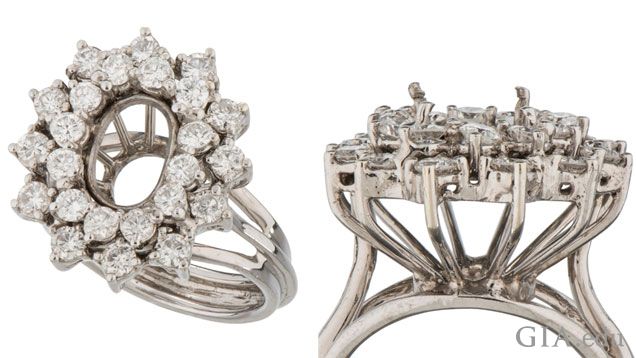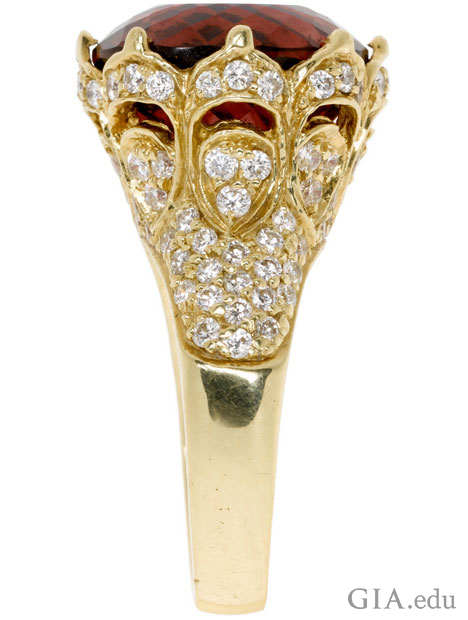Jewelry Detectives: Students Search for Clues to Quality Workmanship, Longevity
July 22, 2019

Jewelry appraiser Teri Brossmer, GIA GG, more than likely saved a recently engaged couple some long-term headaches – and potential heartache – after she examined their engagement ring.
“A newly engaged woman brought in her diamond ring for appraisal and during my inspection I discovered rampant porosity throughout the metal,” she said. “I knew that porosity was not a good thing.”
That’s because Brossmer, who has been a practicing gemologist and jewelry appraiser for 35 years, had recently taken GIA’s Jewelry Forensics seminar, which teaches students to become jewelry detectives as they assess jewelry design and engineering to identify manufacturing methods, workmanship, value and the likelihood of loss or failure.
Brossmer kept those lessons in mind as she looked at the couple’s ring.
“During the class I learned that the porosity we can see on the surface is likely a window into the condition of the entire piece,” she said. “I was able to explain what porosity was and answer my client’s questions. Based on the sheer quantity observed, I suggested she have the ring remade.”
Brossmer’s client returned a few weeks later with a “new ring.”
“Sadly, I had to explain to her that the ring was not new – it had simply been repaired. I was able to show her the areas where the existing porosity had been filled in with solder,” Brossmer said. “The third time was the charm, however, and the next time I saw the ring it passed all of the quality assessment benchmarks I learned from GIA.”
Brossmer said her ability to identify the problems with this ring, and then explain them to her clients, is a direct result of what she learned in the Jewelry Forensics seminar.
That is the goal, said Elizabeth Brehmer, a technical advisor to GIA’s Jewelry Manufacturing Arts program and one of the developers of the seminar.
“Students use the scientific method to correctly identify, analyze and assess the quality and nature of jewelry,” she said. “The forensics skills are used to assess the trace clues that are left over from different forms of manufacturing. These clues help students figure out how the piece was made, its workmanship quality and how it will hold up long-term.”
When they are done, students are able to impartially present what they identify to clients or others.
“It enables you to have a meaningful discussion with a supplier, customer or jeweler about the workmanship and potential risk of loss of a piece of jewelry,” Brehmer said.

The 12 Qualifying Questions and GIA’s Quality Assurance Benchmarks
Once students have collected all of the clues about manufacturing, they learn the 12 Qualifying Questions, which also employ GIA’s Quality Assurance Benchmarks (QABs), to assess the potential risk and loss associated with the piece.
“The QABs are a set of criteria to help determine quality of workmanship and craftsmanship for jewelry,” Brehmer said. “It reviews all of the skills that are employed in making something of quality, including proper dimensions and metrics, such as asking: is this prong the right height and thickness to hold this stone? Is the metal alloy chosen strong enough to be used in a ring?”
The QABs were developed by GIA’s Jewelry Manufacturing Arts instructional and research and development teams as a way to review the daily work and bench tests of Graduate Jeweler (GJ) and Jewelry Design & Technology (JDT) students. They developed the QAB evaluation process and instituted it in 2013 for GJ students and in 2014 for JDT students.
“It has been game-changing. The methodology has made it possible for us to provide consistent, objective feedback to our students in an organized and structured manner,” Brehmer said. “That’s why it made perfect sense to include the 12-step process in the Jewelry Forensics seminar. There isn’t anything else like it out there.”
Brehmer said that applying the QAB criteria for jewelry forensics is one of the many ways that GIA can pass on knowledge learned from one program to another.
“It is a reflection of the synergy that often takes place in the GIA classroom – what we learn in one setting can be leveraged for a whole new and practical aspect of another setting,” she said.
Brossmer said that using GIA’s 12-step process to determine method of manufacture and assess the quality of workmanship was definitely one of the most practical things she learned in the seminar.
“In fact, I carry the Jewelry Forensics handout in my onsite inspection bag,” she said.

Working Through the Jewelry Identification Process
Al Gilbertson, a GIA research associate and one of the seminar developers, likened the Jewelry Forensics seminar to GIA’s graduate gemology program, which teaches students how to identify gemstones.
“It teaches them a methodology that assesses the condition and quality.,” he said. “They are identifying how the piece was made and then evaluating it to see how well it will stand up against risk.”
Brossmer said she took the course because she wanted a better understanding of jewelry manufacturing.
“I wanted to gain more confidence in assessment of the quality and condition of the complete piece of jewelry, ultimately resulting in more credible opinions of value,” she said.
Gina D’Onofrio, director of Fine Jewelry for Heritage Auctions in Beverly Hills, said the seminar “fills a void in jewelry industry education” and “having case studies of pieces utilizing newer techniques, such as castings from CNC milled wax, were valuable to me.”
Both Brossmer and D’Onofrio agreed that what they learned in the seminar will help them when they are evaluating antique and estate jewelry.
“I am more cognizant of how refined newer manufacturing techniques have become and how they can be utilized to make more convincing reproductions of antique and period jewelry,” D’Onofrio said.
Brossmer said she has a better handle on recognizing how a piece was manufactured, which is “invaluable when dating antique and period pieces. The hands-on examples of cast-in-place bead setting versus hand-set gems was also very helpful,” she said.
She has also a clearer understanding of the properties of the precious metals commonly used in jewelry manufacturing and the steps in each of the manufacturing processes.
“It provided an excellent foundation and made the hands-on experience much more meaningful,” she said. I loved the little trick about using a strong magnet to check for cobalt in 950 platinum pieces."
Want to Become a Jewelry Detective?
D’Onofrio offered specific examples of how the Jewelry Forensics seminar will help other jewelry professionals:
- If you take in over-the-counter repairs, you can detect and assess potential problems before they occur.
- If you appraise/buy/sell period jewelry, you can recognize inconsistencies in construction methods for circa dating, and for reproductions.
- If you are a jewelry designer without bench skills, this course will help you design and engineer pieces knowing what construction geometry will prevent potential jewelry failures in the future.
- If you are a buyer for a jewelry store or an avid collector, you can make more informed decisions on the metal type performance, quality and workmanship of the product you are purchasing.
“The usefulness of the Jewelry Forensics class extends beyond the jewelry industry to insurance professionals by assisting them in identifying potential risks,” Brossmer said. “The curriculum provides such a treasure trove of information; I plan to take it again so I can focus on things I’m sure I missed.”
The two-and a half-day Jewelry Forensics seminar offers lecture with process videos, hands-on exercises along with detailed education materials with illustrations and image examples.. Seminar participants will receive a Jewelry Forensics guidebook including the GIA 12-step process of evaluation, glossary of jewelry terms and a thumb drive with supplemental reference and jewelry case study information.
GIA offers the Jewelry Forensics seminar at several times during the year. View all upcoming dates.
Amanda J. Luke is a senior communications manager at GIA. She is the editor of the GIA Insider and Alum Connect and was the editor of The Loupe magazine.
.jpg)


